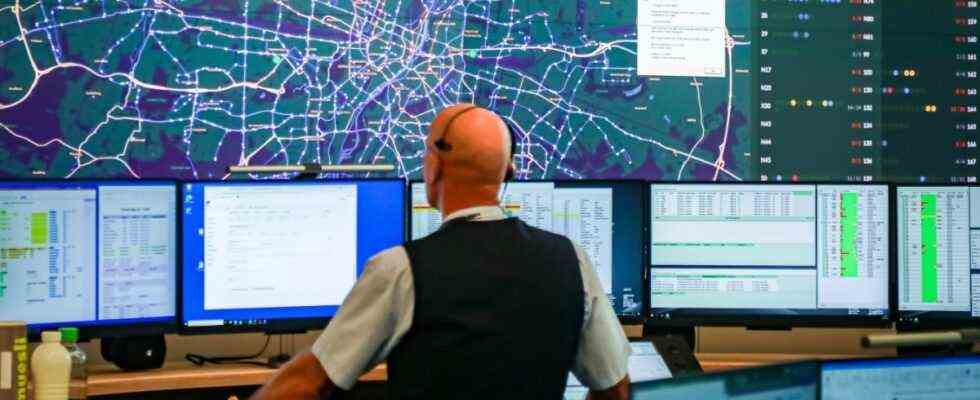And then it happened! So far the morning has been quiet, here an escalator, there a little traffic jam, but otherwise not much has happened. And now, shortly before nine thirty: a broken switch near the U4 in Lehel. The episode can be seen on one of the huge screens over which green dots slide. The dots are the trains of the subway, one of them is now dragging a 7 around with it: seven minutes late because of the switch.
The responsible employee in the operations center of the Münchner Verkehrsgesellschaft (MVG) is therefore quite busy, the drivers of the other trains call in and ask what they should do – wait or continue? And the woman behind the many monitors and telephones on her desk coordinates the individual trains so that the damage to operations and passengers remains as low as possible.
A central control center is particularly important for the underground, explains the head of the operations center, Jens Wagner: “Without us, the trains wouldn’t run at all.” Because the people in the control center operate the signal boxes, among other things. There is also communication with passengers and drivers. If there is a disruption, as happened to a lesser extent with the U4, the employees at the control center ensure that the following trains do not stop in the tunnel, but wait at the stations for their onward journey. A small first step that makes waiting more pleasant for the passengers. “After all, none of us like standing in a tunnel,” says Wagner.
If a colleague cannot come to work, the personnel dispatcher will take care of a replacement
In addition to remedying the fault, it is also necessary to inform the passengers in such a case, which is also provided from the operations center. In addition, MVG has around 100 mechanics in the field who can be quickly sent to the scene if necessary – their coordination is also carried out from the open-plan office in the headquarters of Stadtwerke München (SWM) on Emmy-Noether-Straße. They also have to find solutions here for the small everyday problems: If a colleague has a cold and cannot come to work, the personnel dispatcher will take care of a replacement.
All these problems can be solved by talking to each other, explains Wagner: “Communication is our main tool.” And because that’s the way it is, a phone keeps ringing somewhere, a radio message rustles out of the loudspeakers, an employee speaks. So it is never quiet here, but it is still bearable because of the acoustics of the room.
In the open-plan office, communication is the “main tool”. A telephone rings all the time, a radio message rustles, an employee speaks.
(Photo: Leonhard Simon)
In the old rooms, which were located in an outbuilding, it was a little different. There was quite a reverberation, Wagner recalls. This is one of the reasons why most of them were happy about the move. That was also necessary, because in the past few years the technical possibilities and thus the security requirements have increased enormously. At some point the resources for this were lacking in the old premises: If a power cable was torn there, it could be that the entire control center was paralyzed. “We have everything twice in our new operations center,” explains Wagner. “So: at least twice.”
And there is another innovation: Up until now, the employees responsible for buses and trams were housed separately from the colleagues who kept an eye on the operation of the subway. But if, for example, a subway fails, the traffic shifts to the surface at breakneck speed. In order to meet the demand, additional buses are sometimes required, which the control center has to request. Sometimes, however, the department responsible for buses and trams only found out about the malfunction when the stops were already full of annoyed passengers from the subway. Things are going much better now – since everyone works in one office, says Wagner: “That is also important, because sometimes a few minutes can be very, very important.”
For Jens Wagner, the head of the operations center, the move to the new control center was a blessing.
(Photo: Leonhard Simon)
Since September 30, the Munich buses, trams and underground trains have been coordinated from the new office, and when moving, MVG also had the future in mind. Because politicians want people to ride more bikes and trains, the number of passengers is expected to rise in the next few years, plus large projects such as the construction of the U9. And that’s why there are 34 workplaces in the operations center – with a full occupancy, only 26 people work there so far. “We already thought in perspective,” explains Wagner.
Speaking of perspective: the new control center also has a visitor room – but this will not open until spring at the earliest. The aim is to create as much transparency as possible with the necessary security precautions, says Jens Wagner. And maybe that will help to increase awareness of the enormous effort that is required for the operation of local public transport – and thus reduce the annoyance about the next breakdown on the U4.

